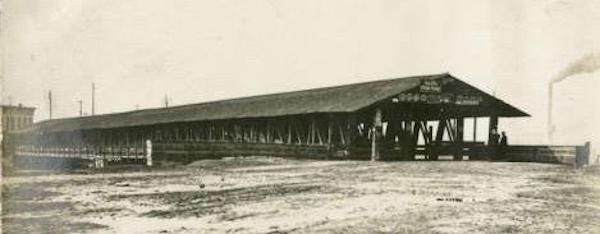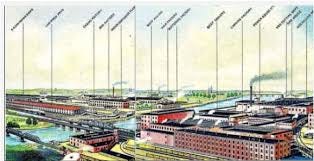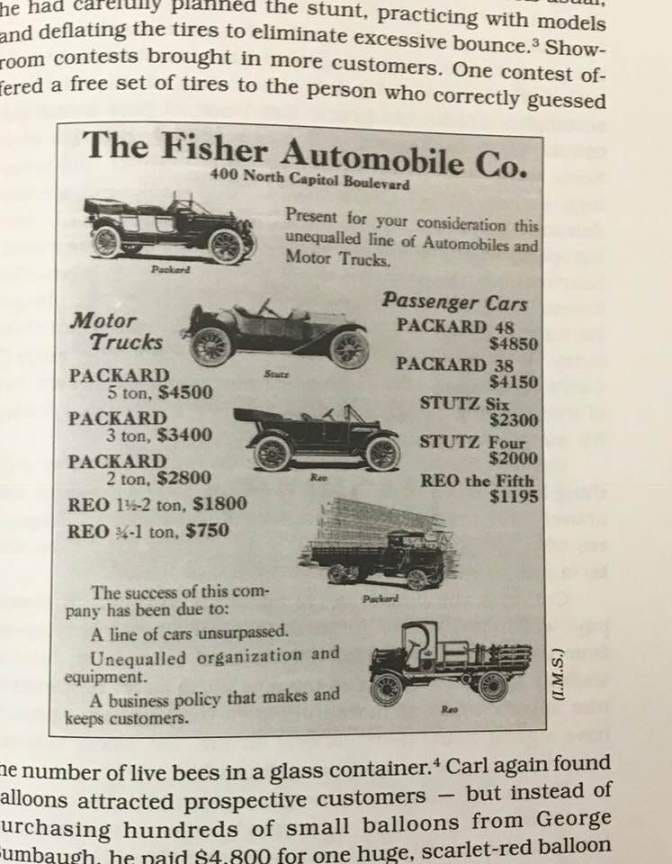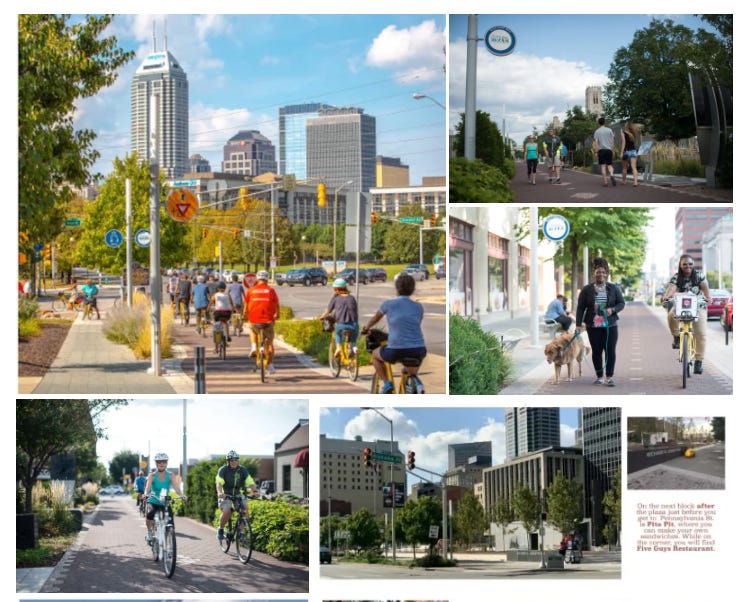Indy’s Impact on America’s Lifestyle and Landscape has no Equal
Indianapolis had more to do with the early formation of America, how Americans eat and how they move themselves about, than any other city in the United States. As I will be showing you, no other city had a bigger impact on the evolution and landscape of America than Indianapolis.
This understanding begins in 1834 when, on its way to the Mississippi River, the National Road from Washington DC crossed the White River in Indianapolis. It was this development that opened up the frontier of the West where there were no white people or roads. While there were other bridges along the National Road that preceded and followed the White River crossing, none of them engendered a riverfront that would help build the West. As half a million fortune seekers, used the covered bridge to get to California and Oregon, soon mills and factories were built near it.
They used the White River to power the water wheels at their production facilities. And then the mills used the bridge to send the flour (for making bread), and cornmeal they had ground to the people of the West.
By 1862 Kingan Pork formed along the White River. Nor was it long before they became the world’s largest pork producer with operations on both sides of the waterway. Their business took off because pork, a staple of the American diet in the 1800s, did not require refrigeration. It could be preserved with salt. Because this was so, they could also ship their meat over the National Road bridge to St Louis, Kansas, and all the brand new markets in the West.
It would take a few decades, but Kingan helped to shift the American diet to beef when one of its engineers, George Stockman, invented mechanical refrigeration in 1868. It was this development that made meat lockers and refrigerated rail cars possible. Because of Stockman’s invention, fresh meat no longer required cattle drives. And as such it led to the end of the cowboy era as it brought about barbed wire and private property.
A year after it invented refrigeration, in 1869 the Transcontinental Railroad connected San Francisco to Chicago. When this happened, Kingan’s pork market expanded even more. It was able to use nearby Union Station (two-blocks away), the east coast rail transfer station, to get its pork and bacon (Kingan was the first to mass produce bacon) to the Windy City and then San Francisco.
At the same time, Van Camp, located a block from Kingan and the river, which had been feeding Civil War troops, was then busy shipping millions of cans of pork and beans to the hungry Americans of the West. With the help of the National Road Bridge and then Union Station, they would go on to become the world’s largest canned foods producer.
In addition to sending food to the West, Indianapolis also helped put an end to slavery. This was so because from 1854 to 1859, thousands of people used the National Road bridge to get to Kansas to establish residency there. Their purpose in doing so was to affect the vote on slavery. In 1861 when Kansas entered the Union as a free state, many of its citizens had come from above the Mason-Dixon line.
Indianapolis also sent tens of millions of people to relocate in California and Oregon. While this migration began with the National Road Bridge in the 1850s, this movement shot into overdrive with its Union Station in 1869. The first train station in the world to serve as a hub for all the different train lines in a city, by 1870, two million people a year were using it to get to the Transcontinental Railroad and then California.
In 1890, Diamond Chain opened its doors. Diamond Chain’s importance to the advancement of civilization cannot be overstated. Without chain, all that motors do is spin. They do not do any work.
While block chain had been invented in 1880, its use was limited because it was so expensive to make. In devising a way to mass produce chain, Diamond Chain made it affordable for the masses. The first beneficiary of this manufacturing breakthrough was the bicycle. Because Penny Farthings don't need chain, this made possible the pedal machine with equal sized wheels we know today that took over America. Fondly associated with the Gay 90s, because Diamond Chain had made them affordable, bicycles were a part of the culture and everywhere to be seen.
Car engines also need chain. As do airplanes, motorboats and the assembly line, etc. As Diamond Chain led what is called the Second Industrial Revolution, its factory grew to become the biggest on the planet,. This also made Indianapolis the high-tech center of the world.
In many ways, Indianapolis was like the Silicon Valley of the USA. Because of Diamond Chain, many of the nation’s best mechanical minds came here. It attracted. America’s top machinists and metal workers, a fair number of whom would go on to collaborate with the nascent automobile industry that was also exploding in Indianapolis.
Known by many industry observers as the birthplace of the automobile, Indianapolis was also arguably, the origin of America’s first automobile, the CH Black of 1891. This, as it was also home to 97 different car manufactures.
Well, before Detroit, Indianapolis gave us the first automobile showroom, the first Auto Row, the first car headlights (making it possible to work in a factory after the sun went down). And the first automobile test track, the Indy 500 Motor speedway, etc., etc.
The Indy 500 race track made Indianapolis the center of the automobile industry. This was so because many car makers set up shop here so they could test their new innovations on the speedway. It became a proving ground for many of the safety and performance features we take for granted today.
A few years later, in the same way it connected California to the East Coast with wagons and then trains, it made it possible for cars to reach California with the Lincoln Highway, the first coast to coast car highway. The long distance, road building frenzy this spawned that continues to this day, changed the landscape of America forever.
Coming full circle, connecting California to the East Coast with bicycles is Indianapolis’s next step in the evolution of America. It has already begun with the labyrinth of greenways that feed the only Downtown Greenway in the world, the Indianapolis Cultural Trail. As the heartbeat of the city, the ICT has revitalized the Crossroads of America, and brought about a building boom that remains unchecked. Soon the renaissance this has brought about will expand to other cities along the National Bicycle Greenway route from San Francisco to Washington DC
Thank you Indianapolis










